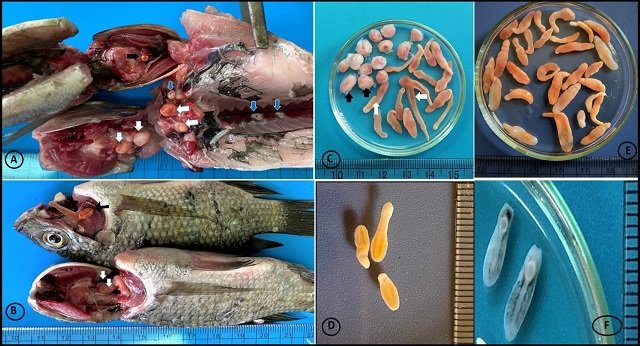
Clinostomid infections represent a significant threat to both fish and human health. This parasitic disease, caused by trematode worms, can lead to various health issues in fish, such as reduced growth, lower reproductive capacity, and even death. In humans, consuming raw or undercooked fish infected with these parasites can result in a condition known as ‘fish-borne trematode disease,’ which can cause abdominal pain, diarrhea, and other symptoms.
A study conducted by scientists from Cairo University and the Veterinary Research Institute in Egypt aimed to gain a deeper understanding of clinostomid infections in Nile tilapia (Oreochromis niloticus). The researchers collected fish and water samples from various locations, including fish farms and the Nile River, to assess the prevalence of these parasites and the factors contributing to their spread.
Clinostomid infections
Clinostomiasis, a parasitic disease caused by the trematode worm genus Clinostomum, poses a significant threat to both fish and human health. The parasites, commonly known as ‘fish trematodes,’ can cause severe damage to fish, leading to reduced growth, reproductive issues, and even death.
In humans, consuming raw or undercooked fish infected with Clinostomum metacercariae can lead to a condition known as ‘fish-borne trematode disease,’ which may cause abdominal pain, diarrhea, and other gastrointestinal symptoms.
The prevalence and impact of clinostomiasis
Studies have shown that Clinostomum infections are widespread in fish populations worldwide, with particular prevalence in aquaculture environments.
The parasites can have a devastating impact on fish health, causing physical injuries, competition for food, and disruption of essential physiological processes. This can lead to reduced marketability of the fish and economic losses for aquaculture producers.
Factors contributing to the spread of clinostomiasis
Several factors can contribute to the spread of Clinostomum infections, including:
- Poor water quality: Contaminated water can provide a suitable environment for parasites to thrive and reproduce.
- Abundance of intermediate hosts: Snails and other aquatic organisms can serve as intermediate hosts for the parasites, facilitating their transmission to fish.
- Presence of definitive hosts: Birds, reptiles, and mammals that feed on fish can act as definitive hosts, completing the parasite’s life cycle and spreading the infection.
The study
The researchers collected a total of 300 Nile tilapia from fish farms and the Nile River. They obtained fish and water samples for morphological, molecular, and histological analyses. They also evaluated water quality parameters.
Stay Always Informed
Join our communities to instantly receive the most important news, reports, and analysis from the aquaculture industry.
The clinostomid metacercariae (MC) recovered were identified based on their morphological characteristics and analysis of the COI gene sequence. The effects of clinostomid infections on the fish’s hematological and biochemical parameters were also evaluated.
Finally, the scientists treated parasitized fish with praziquantel (PZQ) and evaluated the efficacy of the treatment.
Key findings of the study
- High prevalence of clinostomid infections: The study revealed a high prevalence of clinostomid infections in Nile tilapia, indicating a significant threat to the aquaculture industry. The recovered MC were identified as Clinostomum complanatum, C. phalacrocoracis, and Euclinostomum heterostomum.
- Poor water quality: Analysis of water samples from fish farms revealed inadequate water quality, which may create favorable conditions for parasite survival and transmission.
- Impact on fish health: Clinostomid infections were found to have detrimental effects on the health of Nile tilapia, affecting their hematological and biochemical blood parameters.
- Effective treatment: Praziquantel (PZQ) bath treatment was shown to be an effective and safe method for controlling clinostomid infections in fish. The results showed that PZQ treatment (2 mg/L for 24 hours) significantly reduced the number of MC compared to untreated infected fish.
- Environmental link: The study highlighted a link between poor environmental conditions and the prevalence of clinostomid infections, emphasizing the importance of addressing water quality issues to prevent the spread of these parasites.
Importance for Nile tilapia farming
The findings of this study highlight the prevalence and impact of clinostomid infections in Nile tilapia in Egypt. The high prevalence of infections in both farmed and wild fish suggests that the parasites are widespread in the region. Poor water quality in fish farms was identified as a contributing factor to the prevalence of infections.
According to the study’s results, praziquantel was an effective and safe treatment for clinostomid infections in Nile tilapia. However, it is important to note that prevention is key. Improving water quality in fish farms and implementing regular parasite control measures can help reduce the prevalence of clinostomid infections.
Conclusion
This study provides valuable information on the prevalence, morphology, molecular characterization, and treatment of clinostomid infections in Nile tilapia. The findings emphasize the importance of addressing water quality issues in fish farms and implementing effective parasite control measures to protect both fish health and human safety.
The study was funded by the Science, Technology & Innovation Funding Authority (STDF) and was made open access by STDF and The Egyptian Knowledge Bank (EKB).
Contact
Olfat A. Mahdy
Department of Parasitology, Faculty of Veterinary Medicine, Cairo University
Giza, 12211, Egypt
Email: Dr.olfat.mahdy@cu.edu.eg
Reference (open access):
Mahdy, O.A., Attia, M.M., Shaheed, I.B. et al. Evaluation of Praziquantel effectiveness in treating Nile tilapia clinostomid infections and its relationships to fish health and water quality. BMC Vet Res 20, 449 (2024). https://doi.org/10.1186/s12917-024-04279-2
Editor at the digital magazine AquaHoy. He holds a degree in Aquaculture Biology from the National University of Santa (UNS) and a Master’s degree in Science and Innovation Management from the Polytechnic University of Valencia, with postgraduate diplomas in Business Innovation and Innovation Management. He possesses extensive experience in the aquaculture and fisheries sector, having led the Fisheries Innovation Unit of the National Program for Innovation in Fisheries and Aquaculture (PNIPA). He has served as a senior consultant in technology watch, an innovation project formulator and advisor, and a lecturer at UNS. He is a member of the Peruvian College of Biologists and was recognized by the World Aquaculture Society (WAS) in 2016 for his contribution to aquaculture.




